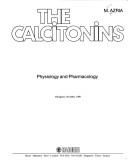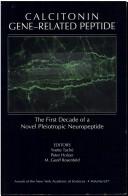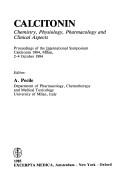| Listing 1 - 10 of 39 | << page >> |
Sort by
|
Dissertation
Year: 1982 Publisher: Maastricht s.n.
Abstract | Keywords | Export | Availability | Bookmark
 Loading...
Loading...Choose an application
- Reference Manager
- EndNote
- RefWorks (Direct export to RefWorks)
Calcitonin --- Calcium --- blood --- blood

ISBN: 3805548516 Year: 1991 Publisher: Bâle, Suisse : Karger,
Abstract | Keywords | Export | Availability | Bookmark
 Loading...
Loading...Choose an application
- Reference Manager
- EndNote
- RefWorks (Direct export to RefWorks)
Calcitonin. --- Thyroid Hormones. --- Calcitonin --- Thyroid hormones --- Calcitonine --- Hormones thyroïdiennes
Dissertation
Year: 1987 Publisher: Liège : Université de Liège. Faculté de médecine (ULg). Département de clinique et pathologie médicales,
Abstract | Keywords | Export | Availability | Bookmark
 Loading...
Loading...Choose an application
- Reference Manager
- EndNote
- RefWorks (Direct export to RefWorks)
MENOPAUSE --- CALCITONIN --- ESTRUS --- ANALYSIS --- MENOPAUSE --- CALCITONIN --- ESTRUS --- ANALYSIS
Book
Year: 1968 Publisher: Amsterdam : Excerpta Medica Foundation,
Abstract | Keywords | Export | Availability | Bookmark
 Loading...
Loading...Choose an application
- Reference Manager
- EndNote
- RefWorks (Direct export to RefWorks)
Calcitonin --- Parathyroid hormone --- Congresses. --- Congresses.
Dissertation
Year: 1984 Publisher: Kobenhavn Laegeforeningens forlag
Abstract | Keywords | Export | Availability | Bookmark
 Loading...
Loading...Choose an application
- Reference Manager
- EndNote
- RefWorks (Direct export to RefWorks)
Calcitonin --- Thyroid Neoplasms --- blood --- blood

ISBN: 089766714X Year: 1992 Volume: 657
Abstract | Keywords | Export | Availability | Bookmark
 Loading...
Loading...Choose an application
- Reference Manager
- EndNote
- RefWorks (Direct export to RefWorks)
Book
ISBN: 8821416607 9788821416606 Year: 1983 Publisher: Milano : Masson,
Abstract | Keywords | Export | Availability | Bookmark
 Loading...
Loading...Choose an application
- Reference Manager
- EndNote
- RefWorks (Direct export to RefWorks)

ISBN: 0444806903 Year: 1985 Volume: vol 663 Publisher: Amsterdam New York Oxford Excerpta medica
Abstract | Keywords | Export | Availability | Bookmark
 Loading...
Loading...Choose an application
- Reference Manager
- EndNote
- RefWorks (Direct export to RefWorks)
Calcitonin --- Congresses. --- Thyrocalcitonine. (Congrès) --- Thyrocalcitonin. (Congres)
Book
Year: 2016 Publisher: Bruxelles: UCL. Faculté de pharmacie et des sciences biomédicales,
Abstract | Keywords | Export | Availability | Bookmark
 Loading...
Loading...Choose an application
- Reference Manager
- EndNote
- RefWorks (Direct export to RefWorks)
Migraine is a chronic neurovascular disease that affects about 15% of the population and is characterized by recurrent episodes of unilateral throbbing headaches with associated symptoms such as nausea, vomiting, photophobia and phonophobia. For many patients, available pharmacological options do not meet their expectations, because of lake of efficacy, side effects for because they have contraindications. Lately, proof-of-concept clinical trials show that the blockade of CGRP receptors, a neuropeptide that is found in 50% of trigeminovascular neurones, can significantly decrease many migraine symptoms without inducing any vasoconstriction and that these molcules are beeing very well tolerated, even in patients with cardiovascular dieases. This leads to the development of many other molecules. None of them did pass the phase 2 of clinical trials but the Telcagepant. This molecule has been shown to be very efficient and well tolerated in the acute treatment of migraine. However, its development has been stopped because of hepatotoxicity concerns have been found out in trials about prophylactic use, but not in its acute use, maintaining absence of pharmacological options for the acute treatment of migraine for migrainers who also suffer from cardiovascular diseases. More recently, antibodies against CGRP or its receptors have been developped for the prophylactic management of migraine and seem to be very promising. The promising nature of all these molecules in the treatment of acute migraine attacks or in its prophylaxis will be discussed. La migraine est un désordre neuro-vasculaire présent chez environ 15% de la population et se manifeste par des épisodes récurrents de céphalées lancinantes hémilatérales associées à de nombreux autres symptômes, tels que nausées, vomissements, photophobie et/ou phonophobie. Pour de nombreux patients, les options pharmacologiques disponibles actuellement sur le marché pour le traitement de leurs crises de migraine ne répondent pas à leurs attentes, par manque d’efficacité, à cause d’effets secondaires mal supportés, ou car ceux-ci leur sont contre-indiqués. Dernièrement, des études « preuve de concept » ont montré que le blocage des récepteurs du CGRP, un neuropeptide présent dans 50% des neurones du système trigémino-vasculaire, diminuait significativement de nombreux symptômes de la crise de migraine sans induire de vasoconstriction et était très bien toléré, y compris chez les patients présentant des pathologies cardiovasculaires, ce qui a mené au développement de plusieurs petites molécules. De ces nombreuses petites molécules étant allées jusqu’en phase II, seul le Telcagepant a été testé en étude clinique de phase III. Celui-ci s’est avéré efficace et très bien toléré dans le traitement de crise de la migraine. Son développement a malheureusement été interrompu par la firme à cause de la détection d’une hépatotoxicité en usage quotidien dans un but prophylactique, maintenant l’absence d’options pharmacologiques de traitement de la migraine aiguë pour les patients migraineux et souffrant de pathologies cardiovasculaires. Plus récemment, des anticorps ciblant le CGRP ou les récepteurs du CGRP sont entrés en développement dans le traitement prophylactique de la migraine et s’avèrent très prometteurs. L’intérêt de toutes ces molécules et leur potentiel dans la prise en charge aiguë ou prophylactique de la migraine sera discuté dans ce mémoire.
Book
Year: 2018 Publisher: Bruxelles: UCL. Faculté de pharmacie et des sciences biomédicales,
Abstract | Keywords | Export | Availability | Bookmark
 Loading...
Loading...Choose an application
- Reference Manager
- EndNote
- RefWorks (Direct export to RefWorks)
CLUSTER Headache: which place for the CGRP antagonists among the existing treatments? The Cluster Headache is a disease characterized by extremely important headaches associated with various facial symptoms. The more and more accurate understanding of the disease allowed discovering promising targets like the CGRP (or Calcitonin Gene-Related Peptide) receptor and its ligand. In this paper will be mentioned the physiopathology and the supposed mode of action of the two new drugs, as well as the estimated epidemiology in Belgium. Then, a review of the treatments used routinely will establish a hierarchy among them as well as to glimpse the qualities and defects of these therapies. Afterwards, an analysis of the data of the two antibodies ( Galcanezumab and Fremanezumab) antagonists of the CGRP ligand in migraine will give an insight into the possible benefits of this new therapy in the Cluster Headache. This will make it possible to estimate the place of the new drugs among those available and currently in research stage to establish management algorithms by including them among the existing treatments. Afterwards, a discussion will open the door of the thinking on the future of the therapies of this disease as well as various expectations for the near future of the CGRP antagonists. Finally, we will conclude with the reasoning process that led to this work and the final answer developed to answer the question initially asked: antibodies against the CGRO will certainly occupy an important place as soon as they are marketed, but will also have to wait for a period of current practice to analyze their long-term viability. L'algie vasculaire de la face, ou Cluster Headache, est une maladie caractérisée par des céphalées extrêmement importantes associées à divers symptômes faciaux. La compréhension de plus en plus précise de la maladie a permis de découvrir des cibles prometteuses comme le récepteur au CGRP (ou Calcitonin Gene-Related Peptide). Dans ce travail, seront évoqués la physiopathologie et le mode d’action présumé des 2 nouveaux médicaments, ainsi que l’épidémiologie estimée en Belgique. Ensuite, un bilan des traitements utilisés de manière courante permettra de dresser une hiérarchie parmi ceux-ci ainsi que d’entrevoir les qualités et les défauts, de ces thérapies. Par après, une analyse des données des deux anticorps (Le Galcanezumab et le Fremanezumab) antagonistes du ligand du récepteur au CGRP dans la migraine donnera un aperçu des bénéfices possibles de cette nouvelle thérapie dans le cadre du Cluster Headache. Ceci permettra d’estimer la place de ces nouveaux médicaments parmi ceux disponibles et encore au stade de la recherche afin d’établir des algorithmes de prise en charge en les incluant parmi les traitements existants. Par après, une discussion ouvrira la porte de la réflexion quant à l’avenir des thérapies de cette maladie ainsi que diverses attentes quant au futur proche des antagonistes du CGRP. Pour terminer, seront reprises en conclusion la démarche de réflexion ayant mené ce travail ainsi que la réponse finale développée permettant de répondre à la question initialement posée : les anticorps dirigés contre le CGRP occuperont certainement une place importante dès leur commercialisation, mais devront également attendre une période de pratique courante pour analyser leur viabilité à long terme.
| Listing 1 - 10 of 39 | << page >> |
Sort by
|

 Search
Search Feedback
Feedback About UniCat
About UniCat  Help
Help News
News